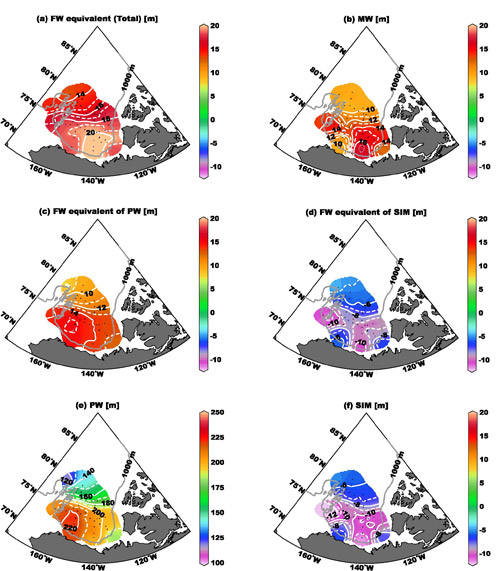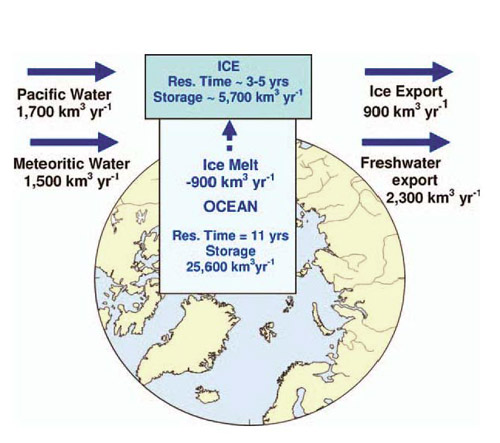Fresh water (FW) composition
Yamamoto-Kawai et al. (2008) developed a method to quantify the mixing ratio of Atlantic Water, (ATW), Pacific Water (PW), meteoric water (MW) and sea ice melt water (SIM) in the Canada Basin. Their approach combines the method of Jones et al. [1998], who found that Pacific and Atlantic waters have different nitrate-phosphate relationships and this difference can be used to estimate the mixing ratio of ATW and PW, and the mass balance equations for S and δO18 to estimate MW and SIM contributions. Using nutrient data from the Chukchi shelf/slope region and the Canada Basin, Yamamoto-Kawai et al. (2008) revised the equation defining Pacific Water. They found that mixing of ATW and PW occurs only in waters with S > 33 in the Canada Basin. Therefore fractions of source water components can be estimated in the Canada Basin using S and δO18 for waters with S ≤ 33, and using S, δO18 and nutrients for S > 33 waters. The estimates of the FW fractions (FW composition) are shown in Figure 1.
This approach was used to describe distributions of source waters over much of the Canada Basin in 2003 and 2004. Amounts of source waters integrated for 0-300 m of the basin together with PW flux through the Bering Sea [Woodgate and Aagaard, 2005] were then used to estimate the freshwater budget of the basin (Figure 2). The transport of fresh water through Bering Strait (2400 km3 per year) accounts for up to 75% of total freshwater input to the Canada Basin. Precipitation and river inflow to the Arctic Ocean add more than 800 km3 per year of fresh water as MW to the Canada Basin. Contributions from Eurasian rivers are required to account for the total MW input to the Canada Basin. Of this combined freshwater influx that enters the Canada Basin, < 900 km3 per year (< 0.6 m per year) is exported as sea ice, and the remainder is exported as liquid water. The mean residence time of PW in the Canada Basin is estimated to be 11 ± 4 years, and somewhat less for MW and SIM. The export of sea ice and liquid fresh water from the Canada Basin contributes ~40% of the freshwater flux exiting the Arctic Ocean.
References
Jones, E. P., L. G. Anderson, and J. H. Swift (1998), Distribution of Atlantic and Pacific waters in the upper Arctic Ocean: Implications for circulation, Geophys. Res. Lett., 25, 765–768.
Woodgate, R. A., K. Aagaard, and T. J. Weingartner (2005), Monthly temperature, salinity and transport variability of the Bering Strait throughflow, Geophys. Res. Lett., 32, L04601, doi:10.1029/2004GL021880.
Yamamoto-Kawai, M., F. A. McLaughlin, E. C. Carmack, S. Nishino, and K. Shimada (2008), Freshwater budget of the Canada Basin, Arctic Ocean, from salinity, δO18, and nutrients, J. Geophys. Res., 113, C01007, doi:10.1029/2006JC003858.

